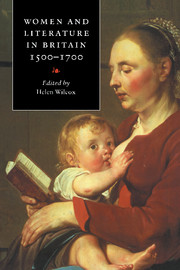Book contents
- Frontmatter
- Contents
- List of contributors
- Acknowledgements
- A note on references
- Chronology: women and literature in Britain, 1500–1700
- Introduction
- Part I CONSTRUCTING WOMEN IN EARLY MODERN BRITAIN
- Chapter 1 Humanist education and the Renaissance concept of woman
- Chapter 2 Religion and the construction of femininity
- Chapter 3 Advice for women from mothers and patriarchs
- Chapter 4 Women reading, reading women
- Chapter 5 Women/‘women’ and the stage
- Chapter 6 Feminine modes of knowing and scientific enquiry: Margaret Cavendish's poetry as case study
- Part II WRITING WOMEN IN EARLY MODERN BRITAIN
- Further reading
- Index
Chapter 2 - Religion and the construction of femininity
Published online by Cambridge University Press: 22 September 2009
- Frontmatter
- Contents
- List of contributors
- Acknowledgements
- A note on references
- Chronology: women and literature in Britain, 1500–1700
- Introduction
- Part I CONSTRUCTING WOMEN IN EARLY MODERN BRITAIN
- Chapter 1 Humanist education and the Renaissance concept of woman
- Chapter 2 Religion and the construction of femininity
- Chapter 3 Advice for women from mothers and patriarchs
- Chapter 4 Women reading, reading women
- Chapter 5 Women/‘women’ and the stage
- Chapter 6 Feminine modes of knowing and scientific enquiry: Margaret Cavendish's poetry as case study
- Part II WRITING WOMEN IN EARLY MODERN BRITAIN
- Further reading
- Index
Summary
Why may not I pray with many people in the room, as well as your professing woman that prays before men and women, she knowing them to be there; but I know not that there is anybody in the room when I pray. And if you indict one for praying, why not another? Why are you so partial in your doings?
These words are taken from the 1654 description of her own trial given by Anna Trapnel, a female prophet of the radical Protestant group the Fifth Monarchists, who lived in expectation of the second coming of Christ in England in the 1650s. Trapnel's prophecies and pamphlets were perceived as religiously and politically subversive since they anticipated the rule of Christ on earth with his ‘saints’ and at the same time expressed criticism of Cromwell, the army and parliament. The above quotation from Trapnel's account identifies a number of issues that are pivotal to the concerns of this chapter on the interrelation of women and religion in early modern Britain. The ostensible reason for Trapnel's indictment was the accusation that she was a witch, but her shrewd responses to her interrogators' questions suggest that their true motivation was a desire to regulate her expression of her religious beliefs.
- Type
- Chapter
- Information
- Women and Literature in Britain, 1500–1700 , pp. 30 - 55Publisher: Cambridge University PressPrint publication year: 1996
- 8
- Cited by



